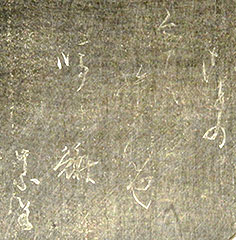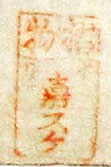Background
 Honobonoto ura no asagiri (Daybreak hidden on the bay by morning fog: 仏暁浦朝霧) is an example of an adauchi mono (revenge tale: 仇打ち物). In this design — one of Hokuei's most dramatic — we see Lady Osuma shining her lantern (andon) on Sasaya Hanbei (an accomplice of the villain in the story, Karahashi Daisuke). The encounter takes place just after he has murdered the fiancée of the play's hero, Kowari Dennai, by throwing her off a cliff. In making his escape, he flings shuriken (star-shaped throwing blades: 手裡劍) at Osuma.
Honobonoto ura no asagiri (Daybreak hidden on the bay by morning fog: 仏暁浦朝霧) is an example of an adauchi mono (revenge tale: 仇打ち物). In this design — one of Hokuei's most dramatic — we see Lady Osuma shining her lantern (andon) on Sasaya Hanbei (an accomplice of the villain in the story, Karahashi Daisuke). The encounter takes place just after he has murdered the fiancée of the play's hero, Kowari Dennai, by throwing her off a cliff. In making his escape, he flings shuriken (star-shaped throwing blades: 手裡劍) at Osuma.
Design
The figures are printed with strong colors, and there are metallic pigments on the sword (katana) and sheath carried by Osuma. The background — a rather sparse, forbidding, and somewhat surreal scene — is printed mostly in shades of gray, showing only a rock or cave on a beach with an ominous night sky.
Hanbei is captured in an expressive gesture as he twists his torso to face Osuma, crossing his legs and lifting his sugegasa (sedge hat: 菅笠) to hide his face. The light of the torch brightens the colors where it falls upon Hanbei's robes, while beyond the cone of illumination there is overprinting with gray to simulate diminished light. Hokuei has used the effects of differentiated luminance to heighten the dramatic impact as Osuma puts the spotlight on evil, its incarnation so startled that he has no time to turn his body completely around to confront her.
There is a poem written in metallic pigment in the sky on the right-hand sheet (difficult to see in the photograph; see enhanced detail above right) signed by the actor Shijaku, whose haigô (poetry name) was also "Shijaku" (紫若). It seems to read: Toukoto no / ôki tabine ya / naku kajika ("Wandering the mountains, I sleep during my journey and hear the croaking of frogs": とふことの多き旅ねや鳴さ鰍). Kajika were frogs admired for their beautiful sound. The verse may allude to the heroine later in the story as she tracks down Hanbei.

 The diptych offered here is from the first-state "surimono-style" edition. The hand-stamped block cutter seal (reading surimono hori Kasuke, "surimono cut by Kasuke": 摺物ホリ嘉スケ) identifies these sheets as coming off wood blocks cut by one of the celebrated names in Osaka printmaking (see seal detail at right).
The diptych offered here is from the first-state "surimono-style" edition. The hand-stamped block cutter seal (reading surimono hori Kasuke, "surimono cut by Kasuke": 摺物ホリ嘉スケ) identifies these sheets as coming off wood blocks cut by one of the celebrated names in Osaka printmaking (see seal detail at right).
The artist seal (see detail at left) is one of many used by Hokuei. The hiragana script on Hokuei's diptych reads fumoto no yuki ("snow on the foothills": ふもとのゆき). This seal might have been derived from one that his teacher Hokushû used (Yoshinoyama, i.e., Mount Yoshino, よしのやま), which was, in turn, based on a seal used by the Edo master Katsushika Hokusai (Fujinoyama, i.e., Mount Fuji, ふじのやま).
There is a second state in deluxe-style with the mark of the publisher Iden, but lacking the Kasuke surimono seal (see OSP in the Bibliography).
The preservation of colors in this impression is excellent, made even more desirable by the surimono-quality block carving by Kasuke and the early printing. What appears to be an entirely black kimono worn by Osuma is actually burnished with a pattern that becomes more visible when illuminated from an oblique angle.
References: IBKYS-II, no. 298; KNP-6, p. 255; IKB-I, no. 2-427; DSH, pl. 10 and no. 3; OSP, no. 152; IPO, no. 1